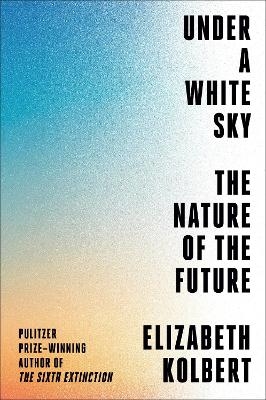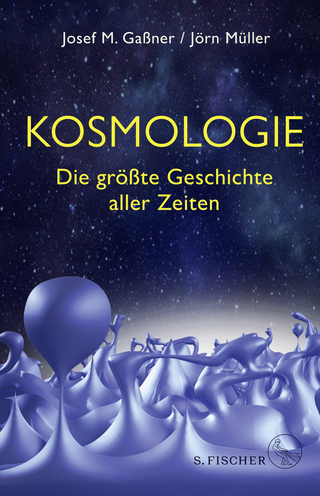
Under a White Sky
Crown Publishing Group, Division of Random House Inc (Verlag)
978-0-593-23877-6 (ISBN)
- Titel ist leider vergriffen;
keine Neuauflage - Artikel merken
5 ideas for summer reading Bill Gates, GatesNotes Beautifully and insistently, Kolbert shows us that it is time to think radically about the ways we manage the environment. Helen Macdonald, The New York Times
That man should have dominion over all the earth, and over every creeping thing that creepeth upon the earth is a prophecy that has hardened into fact. So pervasive are human impacts on the planet that it s said we live in a new geological epoch: the Anthropocene.
In Under a White Sky, Elizabeth Kolbert takes a hard look at the new world we are creating. Along the way, she meets biologists who are trying to preserve the world s rarest fish, which lives in a single tiny pool in the middle of the Mojave; engineers who are turning carbon emissions to stone in Iceland; Australian researchers who are trying to develop a super coral that can survive on a hotter globe; and physicists who are contemplating shooting tiny diamonds into the stratosphere to cool the earth.
One way to look at human civilization, says Kolbert, is as a ten-thousand-year exercise in defying nature. In The Sixth Extinction, she explored the ways in which our capacity for destruction has reshaped the natural world. Now she examines how the very sorts of interventions that have imperiled our planet are increasingly seen as the only hope for its salvation. By turns inspiring, terrifying, and darkly comic, Under a White Sky is an utterly original examination of the challenges we face.
lt;b>Elizabeth Kolbert is the author of Field Notes from a Catastrophe: Man, Nature, and Climate Change and The Sixth Extinction, for which she won the Pulitzer Prize. For her work at The New Yorker, where she s a staff writer, she has received two National Magazine Awards and the Blake-Dodd Prize from the American Academy of Arts and Letters. She lives in Williamstown, Massachusetts, with her husband and children.
Chapter 1
Rivers make good metaphors too good, perhaps. They can be murky and charged with hidden meaning, like the Mississippi, which to Twain represented the grimmest and most dead-earnest of reading matter. Alternatively, they can be bright and clear and mirror-like. Thoreau set off for a week on the Concord and Merrimack Rivers and within a day found himself lost in reflection over the reflections he saw playing on the water. Rivers can signify destiny, or coming into knowledge, or coming upon that which one would rather not know. Going up that river was like traveling back to the earliest beginnings of the world, when vegetation rioted on the earth, Conrad s Marlow recalls. They can stand for time, for change, and for life itself. You can t step into the same river twice, Heraclitus is supposed to have said, to which one of his followers, Cratylus, is supposed to have replied, You can t step into the same river even once.
It is a bright morning following several days of rain, and the not-quite-river I am riding is the Chicago Sanitary and Ship Canal. The canal is a hundred and sixty feet wide and runs as straight as a ruler. Its waters, the shade of old cardboard, are flecked with candy wrappers and bits of Styrofoam. On this particular morning, traffic consists of barges hauling sand, gravel, and petrochemicals. The one exception is the vessel I m on, a pleasure craft named City Living.
City Living is outfitted with off-white banquettes and a canvas awning that snaps smartly in the breeze. Also on board are the boat s captain and owner and several members of a group called Friends of the Chicago River. The Friends are not a fastidious bunch. Often their outings involve wading knee-deep in polluted water to test for fecal coliform. Still, our expedition is slated to take us farther down the canal than any of them has ever been before. Everyone is excited and, if truth be told, also a little creeped out.
We have made our way into the canal from Lake Michigan, via the Chicago River s South Branch, and now are motoring west, past mountains of road salt, mesas of scrap metal, moraines of rusted shipping containers. Just beyond the city limits, we skirt the outflow pipes of the Stickney plant, said to be the largest sewage operation in the world. From the deck of City Living, we can t see the Stickney, but we can smell it. Conversation turns to the recent rains. These have overwhelmed the region s water-treatment system, resulting in combined sewer overflows, or CSOs. There is speculation about what sort of floatables the CSOs have set adrift. Someone wonders if we ll encounter any Chicago River whitefish, local slang for used condoms. We chug on. Eventually, the Sanitary and Ship Canal joins up with another canal, known as the Cal-Sag. At the meeting of the waters, there s a V-shaped park, featuring picturesque waterfalls. Like just about everything else on our route, the waterfalls are manufactured.
If Chicago is the City of the Big Shoulders, the Sanitary and Ship Canal might be thought of as its Oversized Sphincter. Before it was dug, all of the city s waste the human excrement, the cow manure, the sheep dung, the rotting viscera from the stockyards ran into the Chicago River, which, in some spots, was so thick with filth it was said a chicken could walk from one bank to the other without getting her feet wet. From the river, the muck flowed into Lake Michigan. The lake was and remains the city s sole source of drinking water. Typhoid and cholera outbreaks were routine.
The canal, which was planned in the closing years of the nineteenth century and opened at the start of the twentieth, flipped the river on its head. It compelled the Chicago to change its direction, so that instead of draining
| Erscheinungsdatum | 09.02.2021 |
|---|---|
| Zusatzinfo | MAPS, ILLUSTRATIONS |
| Verlagsort | New York |
| Sprache | englisch |
| Maße | 139 x 209 mm |
| Gewicht | 283 g |
| Themenwelt | Sachbuch/Ratgeber ► Natur / Technik ► Naturwissenschaft |
| Naturwissenschaften ► Biologie ► Ökologie / Naturschutz | |
| Technik ► Umwelttechnik / Biotechnologie | |
| Schlagworte | activism • animals • Anthropocene • Appalachia • Biology • business • Climate • climate change • climate change books • climatology • conservation • earth • earth day books • Ecology • Economics • ecosystem • Elizabeth Kolbert • Energy • Engineering • Environment • environmental • environmental books • Environmental Ethics • Environmental Science • Essays • fish • Flood • Geography • Geology • global warming • Hydrology • Nature • nature books • nature lover gifts • ocean • Philosophy • plants • political books • Politics • restoration • river • Science • science book • science books • science books for adults • science gifts • science gifts for adults • Silent Spring • Social • sustainability • Sustainable living • wildlife • wildlife conservation |
| ISBN-10 | 0-593-23877-X / 059323877X |
| ISBN-13 | 978-0-593-23877-6 / 9780593238776 |
| Zustand | Neuware |
| Haben Sie eine Frage zum Produkt? |
aus dem Bereich


